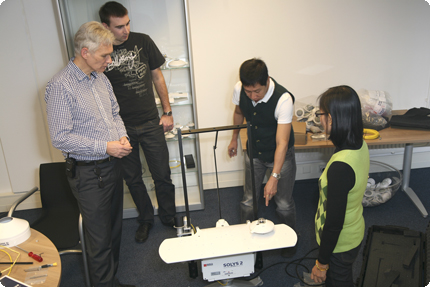PAGASA visits Delft to learn more about the SOLYS 2 sun tracker
Published: Monday, August 13, 2012
PAGASA stands for Philippine Atmospheric, Geophysical and Astronomical Services Administration. In January we had the pleasure to welcome two representatives of PAGASA who run the National Solar Radiation Center of the Philippines. Ms. Vivien Esquivel and Mr. Arman Griarte recently purchased a range of our products and took the trouble to travel to Delft, the Netherlands, for hands-on training by the specialists of Kipp & Zonen.
Why did you travel all the way to the Netherlands?
“In 2010 we’ve proposed a plan to enhance our solar radiation center in Luzon to our government. At that time we only had CMP 3 pyranometers available to measure global solar radiation. Furthermore we use 60 Campbell Stokes sunshine duration devices to measure sunshine duration throughout the Philippines. The new project involves a full solar monitoring station to measure global, direct and diffuse radiation as a reference to improve solar radiation data locally. We are happy that Ms. Chit of State Alliance Enterprises could offer us the high quality instruments of Kipp & Zonen and included training at the head office with it. It is the first time we are going to work with a sun tracker and pyrheliometer and we are looking for reference information and practical experience.”
What initiated the expansion of your meteorological network?
“In the last year the demand for solar radiation data is growing. We received inquiries for it from scientists, solar energy projects and researchers for solar power plants for example. At this moment 80 % of the energy for Philippines comes from fossil fuels. There are no solar energy power plants at this moment while we are in a tropical area and we should harness all the sunshine hours. There is also a lot of interest for solar data by engineers and students that are investigating the potential of our country’s location. But we only measure solar radiation on three strategic locations right now: two locations in island group Luzon, one in Mindanau and none in Visayas.”
Why the choice for Kipp & Zonen?
“Other than the specifications and quality of your products, we have done a lot of research. Browsing the internet showed a lot of countries that are using Kipp & Zonen. But also, we have visited the intercomparisons of the Armstrong pyrheliometer in Davos in 2000, 2005 and 2010. Where we have seen your CHP 1 and met with your colleagues. We interviewed them thoroughly to learn everything there is to know about the pyrheliometer. After the last intercomparison we were convinced and in 2011 the project got a jumpstart for the expansion with eleven CMP 3 pyranometers, a SOLYS 2 sun tracker, a CHP 1 pyrheliometer, three CMP 6 pyranometers, a CSD 3 sunshine duration sensor, a UVS-E-T to measure UV radiation, a CNR 2 net radiometer, METEON and a LOGBOX SD datalogger.”

What will be the purpose of the instruments?
“Our Center is part of the NCRS (National Capital Region Services) and we are going to expand our network with internet data communication and we will incorporate the CMP 3 in the automatic weather stations (AWS). The SOLYS 2 and other instruments will be used for our reference station in Luzon and are part of the new National Solar Radiation Center that we are building. Mr. Griarte will operate the instruments and Ms. Esquivel manages the data.”
Did you enjoy your training and stay in Delft?
“Yes, very much. The training was very informative and we learned a lot. You were very hospital and we are also thankful to Ms. Chit for making all the arrangements for us. We’ve seen your products during the intercomparsion in Davos and they are state-of-the-art. Therefore we’ve insisted on training. But already in preparation of the training we’ve been in contact with your customer support engineer who also helped us with immediate assistance. This experience provides us with the knowledge we need and we are ready to get started!”
More information on PAGASA: http://www.pagasa.dost.gov.ph/